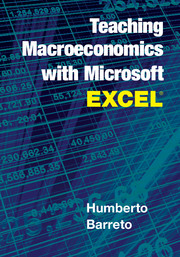Book contents
- Frontmatter
- Dedication
- Contents
- Preface
- Software Requirements and Opening a Macro-Enhanced Workbook
- Introduction:Why Simulation and Excel?
- 1 Charting in Excel
- 2 Economic Growth Literacy
- 3 The Solow Model
- 4 Macro Data with FRED in Excel
- 5 The Keynesian Model
- 5.1 Introduction
- 5.2 The Keynesian Cross: KCross.xls
- 5.3 The Money Market: MoneyMarket.xls
- 5.4 The ISLM Model: ISLM.xls
- 5.5 The ISLMADAS Model: ISLMADAS.xls
- References
5.4 - The ISLM Model: ISLM.xls
from 5 - The Keynesian Model
Published online by Cambridge University Press: 05 May 2016
- Frontmatter
- Dedication
- Contents
- Preface
- Software Requirements and Opening a Macro-Enhanced Workbook
- Introduction:Why Simulation and Excel?
- 1 Charting in Excel
- 2 Economic Growth Literacy
- 3 The Solow Model
- 4 Macro Data with FRED in Excel
- 5 The Keynesian Model
- 5.1 Introduction
- 5.2 The Keynesian Cross: KCross.xls
- 5.3 The Money Market: MoneyMarket.xls
- 5.4 The ISLM Model: ISLM.xls
- 5.5 The ISLMADAS Model: ISLMADAS.xls
- References
Summary
Paul Krugman recently wondered how many macroeconomists still believe in the IS-LM model. The answer is probably that most do, but many of them probably do not know it well enough to tell.
– Olivier BlanchardQuick Summary
To access ISLM.xls, visit
http://www.depauw.edu/learn/macroexcel/excelworkbooks/ISLMModel/ISLM.xls
ISLM.xls implements the ISLM Model with an initial emphasis on the idea of a feedback mechanism and stresses the equilibration process. This workbook also enables a variety of comparative statics and multiplier analyses. Exploration of the properties of the model under various parameter values and elasticities is emphasized.
Screencasts
There are eleven screencasts organized into three groups:
Group 1: The first four screencasts are focused on the initial equilibrium and how it is obtained.
• http://vimeo.com/econexcel/islmintro: introduces the ISLM Model with a no-feedback version of the model where income does not affect money demand; when we make money demand a function of income, in the next screencast, the power and effectiveness of the IS and LM curves become immediately clear
• http://vimeo.com/econexcel/islmequilibration: shows how the goods and money markets are interconnected and how the intersection of IS and LM reveals the general equilibrium solution
• http://vimeo.com/econexcel/islmassetmarket: shows how an ISLM Model with asset market equilibration works by displaying an economy crawling along the LM curve to its equilibrium solution
• http://vimeo.com/econexcel/islmstability: shows how the slopes of the IS and LM curves determine if the equilibrium solution is stable under a cobweb equilibration process
Group 2: The next three screencasts are concerned with the mechanics of the model itself and how it functions.
• http://vimeo.com/econexcel/islmderive: derives the IS and LM curves as equilibrium solutions – for IS, Ye given r, and for LM, re given Y
• http://vimeo.com/econexcel/islmshifting: shows how to correctly shift curves depending on the placement of the exogenous variable; emphasizes that for shocks that do not affect the slope, the IS curve shifts left and right, while the LM curve shifts up and down
• http://vimeo.com/econexcel/islmcrowdingout: how multipliers are attenuated (lessened) when the model is extended because investment is crowded out as interest rates rise in response to attempts to stimulate the economy
Group 3: The final four screencasts are devoted to the comparative statics properties of the model, including applications and analysis of fiscal and monetary policy.
Information
- Type
- Chapter
- Information
- Teaching Macroeconomics with Microsoft Excel® , pp. 157 - 168Publisher: Cambridge University PressPrint publication year: 2016
